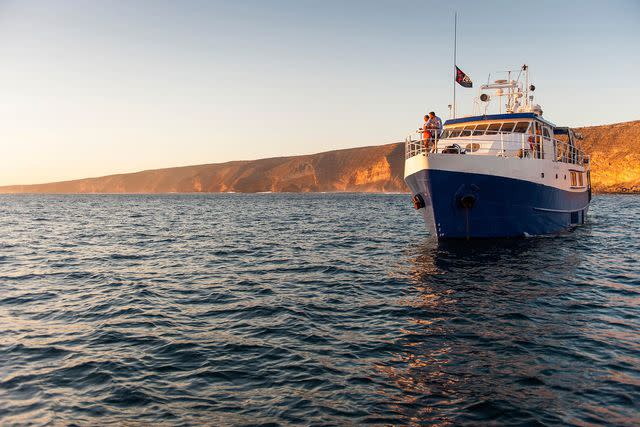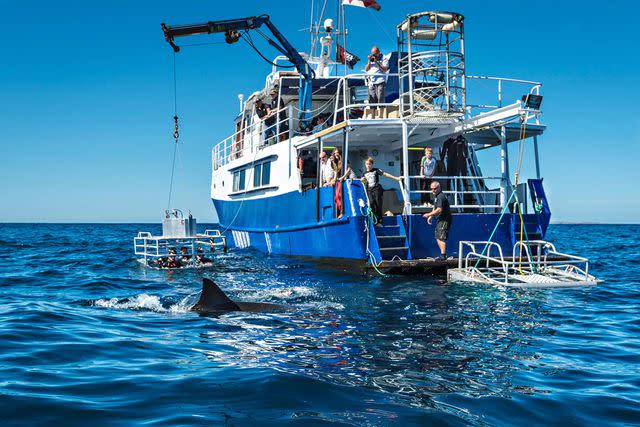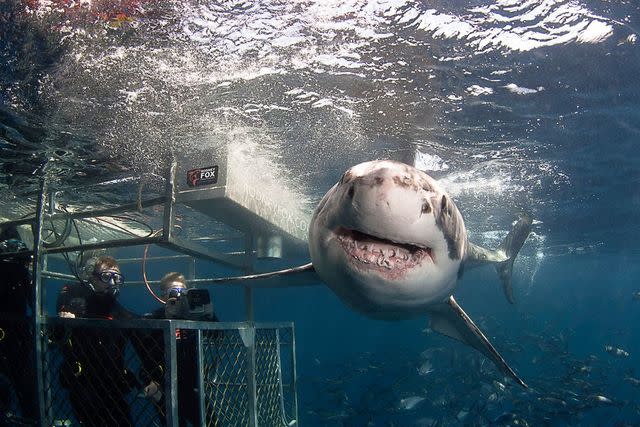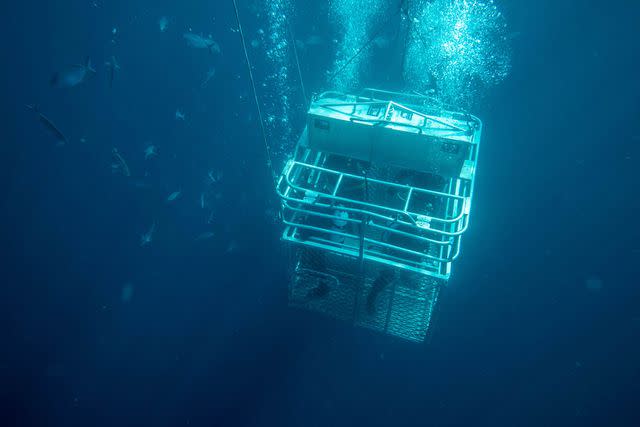I Went Cage Diving With Great White Sharks Off the Coast of South Australia — Here's How You Can, Too
Here's how you can have this once-in-a-lifetime experience.

Hayden Richards/Courtesy of South Australian Tourism Commission
The opening power chords of "Eye of the Tiger" tear through the stillness surrounding the Neptune Islands, startling a group of resting seagulls into the air. My expedition leader, Harrison Tozer, has chosen an eyebrow-raising song to accompany his team as they lower a huge shark-proof metal cage into the water off the boat's stern. Air bubbles billow to the surface and seemingly burst in time with the music. "Face to face, out in the heat. Hanging tough, staying hungry," croons Dave Bickler over the speakers.
If great white sharks had a Spotify playlist, Survivor would certainly be on it, alongside Guns n' Roses, Metallica, and Iron Maiden. There's no hard science to prove it, but Tozer tells me sharks love heavy rock, so the crew plays music while they're preparing the first dives of the expedition.

Adam Bruzzone/Courtesy of Rodney Fox Shark Expeditions
A half-day sail from Port Lincoln, a fishing town west of Adelaide in South Australia, has brought us to the southern Neptune Islands — two scraps of land pummeled over thousands of years by Antarctic waves and winds. It's a dramatic place to meet a great white shark (technically named "white sharks"), drawn here thanks to the colony of long-nosed fur seals that call the islands home.
Rodney Fox Shark Expeditions has been running live-aboard diving tours here for more than 50 years, regularly hosting cadres of wildlife photographers and shark scientists from Flinders University alongside curious GoPro-touting travelers. I joined them because I wanted to uncover the truth behind one of Hollywood's most enduring baddies — a villain that the company's founder, Rodney Fox, helped create.
At 23 years old, Fox became a local legend after surviving a ferocious great white shark attack during a spearfishing competition in 1963. Fox was a keen diver before the attack but became increasingly fearful of open water afterward. Realizing the only way to overcome his fear was to confront it, Fox started to seek out sharks and learn everything he could about them, going as far as constructing submersible cages that would enable him to safely swim near and photograph sharks.

Adam Bruzzone/Courtesy of Rodney Fox Shark Expeditions

Adam Bruzzone/Courtesy of Rodney Fox Shark Expeditions
Fox's exploits eventually caught the attention of Steven Spielberg, then a little-known movie director, who asked him to help film real sharks for a project called "Jaws." The movie was a box-office hit but a public relations disaster for sharks. Fox has since said he regrets his involvement with the film and vowed to continue educating the public about the importance of sharks in our oceans. At 82, he no longer joins the expeditions but has since passed the business down to his son, Andrew Fox, and his business partner, Mark Tozer (who is Tozer's father).
A dorsal fin starts to circle the boat nearly an hour after we drop the cage. "Who wants to be the appetizer?" asks Tozer. Within minutes, I’m in a wetsuit and climbing down the ladder into the cage. The initial shock of cold water gives way to weightless confusion as the force of the ocean current throws me around like a rag doll.

Hayden Richards/Courtesy of South Australian Tourism Commission
I manage to anchor my toes to the cage bottom in time to spot my first great white shark as it emerges out of the blue and silently swims toward me. There’s no film score, no heavy rock, just my escalating heartbeat punctuated by bubbles gurgling from my regulator.
The apex predator approaches the cage, then suddenly turns with complete indifference to the stunned human inside watching her. I’m so close I can see her eyes are dark blue and she has a beauty spot on one side. The schools of kingfish surrounding the boat also seem unfazed by her presence, even though she could turn and eat them at any moment. Soon, more sharks join us until I count half a dozen great whites circling above and below me.

Greg Snell/Courtesy of Tourism Australia
Back on board, Tozer tells me the shark I met is Coco Pops — so named for her distinctive beauty spot — and that the crew has names for some of their regular visitors. Imax has a deformed tail caused by scoliosis, while Santa has a white tumor on his chin that looks like a beard. Despite the funny names, there’s a raw power and majesty to these animals, too. More than once, I watch as a shark lunges, mouth wide and eyes rolled back, at a chunk of tuna belly thrown off the boat on a fishing line. It’s the crew’s job to ensure the shark never catches the bait, but every now and then, the shark succeeds.

Adam Bruzzone/Courtesy of Rodney Fox Shark Expeditions
The next four days pass by in a blur of bubbles. A second cage is deployed to the sea floor twice daily for guests with PADI diving certification, while the surface cage is available all day long for non-divers like me. In between dives, we’re treated to buffet lunches and dinners, where we all gather to compare GoPro photos and see who got the best action shots.
At night, Tozer and the crew present educational seminars on shark ecology and conservation, each time peeling back the mystique of these incredible animals. I learned the company has played a key role in testing new shark technology, like shark-proof wetsuits and small pills that are fed to the animals to help scientists monitor their diet and feeding habits.
On the last morning, just before we haul anchor and sail back to Port Lincoln, there’s one final call to jump in the cage. Goggles in hand, I plunge into the water for my last shark encounter, but this time, I realize there’s no fear — only admiration.
For more Travel & Leisure news, make sure to sign up for our newsletter!
Read the original article on Travel & Leisure.